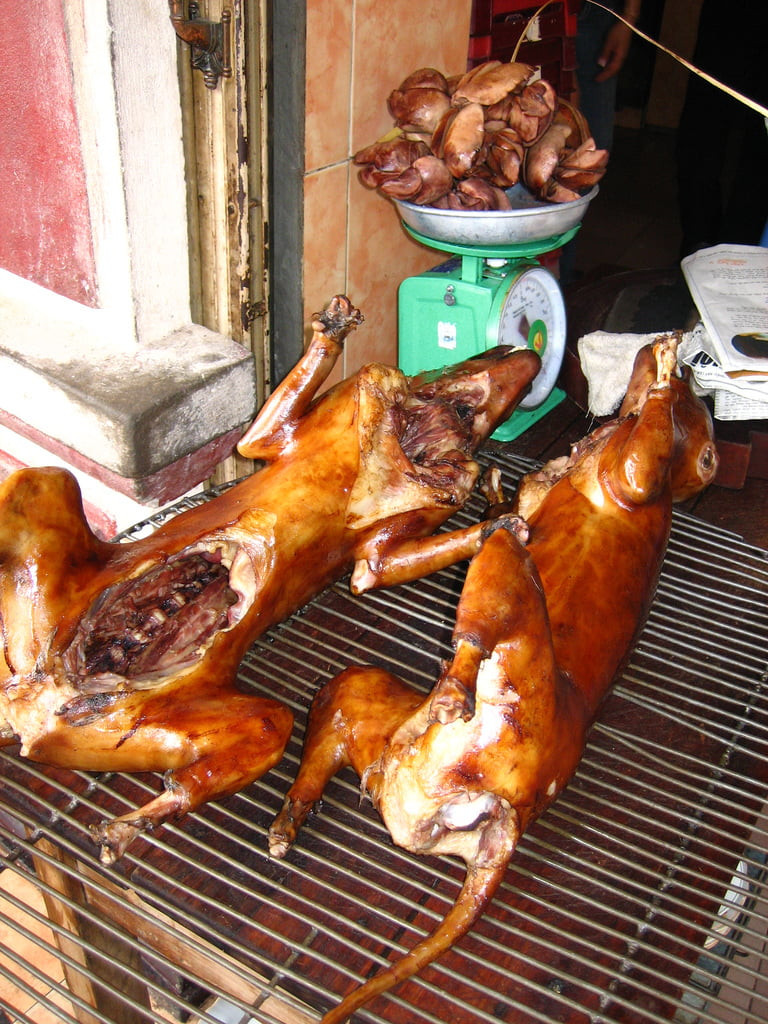Are you curious about What Countries Eat Dogs And Cats? This question might seem shocking, but the practice exists in certain parts of the world. On solcat.net, we delve into this complex topic, shedding light on the cultural and historical contexts behind the consumption of canine and feline meat. Understanding this issue helps us promote animal welfare and cultural sensitivity.
Interested in learning more about animal welfare and cultural practices surrounding cats and dogs? Stay with solcat.net to uncover the surprising truths and ethical considerations of consuming companion animals, like the dog meat trade and cat consumption. Let’s explore the intersection of culture, cuisine, and compassion together.
1. Is Dog Meat Consumption Legal in China?
While many in China keep dogs as pets, with approximately one dog for every ten people (around 130 million pet dogs), eating and selling dog meat remains legal in many areas. This practice is a tradition that dates back thousands of years. Ancient Chinese writings from the Zhou Dynasty mention dogs, pigs, and goats as animals bred for food. However, it’s a complex issue with varying regional regulations and growing opposition from animal welfare advocates.
1.1. How Prevalent is the Dog Meat Trade in China?
Despite the popularity of dogs as pets, an estimated 10 million dogs are killed annually for their meat, some even skinned alive. This “fragrant meat,” as it’s sometimes called, is openly sold in restaurants.
1.2. What Beliefs Support Eating Dog Meat in China?
Some believe dog meat raises body temperature, boosts overall health, promotes warmth and blood circulation, and enhances male fertility. These beliefs contribute to the demand for dog meat, particularly during colder months.
1.3. What About the Fur Industry in China?
China is the world’s largest producer, consumer, and exporter of fur garments, often made from mink, fox, and raccoon dog. In places like Shangcun, a significant portion of unprocessed fur is traded openly. There are few restrictions on the fur trade, leading to inhumane practices where animals are often skinned alive. China also boasts the largest dog skin industries globally.
 Dogs being butchered in Guangdong, China in 1999, highlighting the historical practices of the dog meat trade
Dogs being butchered in Guangdong, China in 1999, highlighting the historical practices of the dog meat trade
2. Is Dog Meat a Part of South Korean Cuisine?
In South Korea, dog meat consumption exists, although it’s a contentious issue with increasing calls for its ban. There are over 20,000 restaurants that offer dog meat, and dog meat eating festivals are held regularly. The industry is estimated to be worth US$2 billion, despite the absence of clear laws governing the dog meat trade.
2.1. How Many Dogs are Consumed in South Korea Annually?
It is estimated that over 2.5 million dogs are consumed annually in South Korea, along with over 100,000 tons of dog meat. Consumption is particularly high during the summer, driven by the belief that it helps keep one cool.
2.2. What is the Legal Status of Dog Meat in South Korea?
The legal status is ambiguous. While there aren’t explicit laws banning dog meat consumption, there have been legal challenges and debates surrounding the issue. Recent court decisions have classified killing dogs for meat as illegal, signaling a potential shift in the legal landscape.
3. Is Eating Dog Meat Common in the Philippines?
Eating dog meat is not uncommon in the Philippines, where an estimated half a million dogs are slaughtered annually. It is the third most popularly consumed meat after pork and goat. The dish “Asocena,” primarily consisting of dog meat, is well-known.
3.1. What is “Asocena” and Where is Dog Meat Trade Centered?
“Aso” is a Filipino word for dog, and “cena” means dinner or evening meal, hence “Asocena.” The city of Baguio, in the Island province of Benguet, is a hub of the dog meat trade.
 Dog meat displayed, showcasing the reality of dog consumption in some regions
Dog meat displayed, showcasing the reality of dog consumption in some regions
4. How Popular Is Dog and Cat Meat in Vietnam?
In Vietnam, both dogs and cats are consumed, with a long-standing tradition. Fried cat meat with beer is a popular dish in Hanoi. Methods of slaughter can be brutal. Similarly, dogs are eaten, with a centuries-old tradition of worshipping stone statues of dogs.
4.1. What are Some Common Beliefs About Eating Dog Meat in Vietnam?
Dog meat is believed to bring good fortune. It is a relatively expensive, dinner-time restaurant meal eaten throughout Vietnam.
4.2. How Many Animals are Consumed Annually?
Vietnam devours about five million animals a year.
4.3. What Terms Are Used to Refer to Dog and Cat Meat in Restaurants?
To avoid controversies, many restaurants use the words “Thit Cay,” meaning “meat of small and medium-sized animals,” instead of “Thit Cho” (dog meat) or “Thit Meo” (cat meat).
4.4. Where is the Epicenter of Vietnam’s Dog-Meat Industry?
Son Dong, in Thanh Hoa province, is the epicenter. Thousands of dogs arrive here, are force-fed to increase their weight, and then transported to slaughterhouses.
5. Is the Dog Meat Trade Present in Thailand?
The dog meat and dog skin trade exist in Thailand, although it is illegal. Ta Rae, a town along the Mekong River, is a hub for illicit dog stealing, smuggling, and trafficking.
5.1. How Does Dog Theft Occur in Thailand?
Dog thieves use makeshift stun guns connected to motorcycle batteries to knock out pet dogs. The unconscious animals are then sold to traders and smuggled across the Mekong River to Laos, en route to Vietnam.
5.2. Where is the Dog Skin Industry Centered?
The dog skin industry is centered in Sakon Nakhon in Northeast Thailand. An estimated 2,000 dogs are stolen and smuggled across the border every week.
5.3. What are Dog Skins Used For?
Dog skins are used to make golf gloves and drums, and as low-cost linings by shoe-makers. The soft dog scrotums are prized for golf gloves. Dog skin is exported to Japan, China, and Taiwan for musical instruments and sometimes end up as rawhide bones for pet dogs.
6. Is Laos a Dog Trafficking Hub?
Yes, Laos is a significant dog trafficking hub between Thailand and Vietnam.
6.1. How Many Dogs are Smuggled Through Laos?
Almost every night, thousands of stolen and stray dogs are caught and smuggled across the Mekong River from Thailand to Laos en route to Vietnam.
7. Was Dog Meat Consumption Ever Legal in Taiwan?
Dog meat was once called “fragrant meat” in Taiwan. It was eaten, especially black dogs, in the winter months to retain body warmth.
7.1. What is the Current Legal Status of Dog Meat in Taiwan?
The Taiwanese parliament passed a law banning people from eating dog meat and imposed a fine for violations. The ban was introduced in 1988 to avoid adverse publicity during the Seoul Olympics.
7.2. Is the Ban Effectively Enforced?
Despite the ban, dog meat was still part of the menu in over 100 restaurants throughout Taiwan, but enforcement has become stricter in recent years.
8. How Common is Dog Meat Consumption in Indonesia?
In Indonesia, the predominantly Muslim population generally considers eating dog or pork meat unclean and “haraam” (forbidden). However, some ethnic communities, such as the Minahasa and Toraja, traditionally eat dogs, cats, forest rats, and fruit bats.
8.1. Which Communities in Indonesia Consume Dog Meat?
The Minahasa, an ethnic Christian majority tribal community, and the Toraja, an ethnic mostly Christian people, consume dog meat. The Batak Toba culture also eats a dish called “saksang” made from dog meat stew.
8.2. When Do the Bataks Consume Dog Meat?
The Bataks of northern Sumatra consider dog meat to be a festive dish, reserved for celebrations like weddings and Christmas.
8.3. What is a Popular Indonesian Dog Meat Dish?
A popular Indonesian dog meat dish is called “rintek wu’uk rica-rica” (dog meat).
8.4. Is There Illegal Dog Trade in Indonesia?
Yes, there is a flourishing black market for stolen dogs in Bali, where dog catchers steal dogs and sell them to dog meat factories.
9. Is Dog Meat Part of Polynesian History?
Dog meat is indeed part of Polynesian and Hawaiian history.
9.1. How Was Dog Meat Viewed in Ancient Hawaii?
In the past, the meat of the Hawaiian poi dog was considered a delicacy reserved for consumption during feasts and religious festivals. It was served only to men and considered ‘kapu’ or forbidden for women.
9.2. Who Traditionally Consumed Dogs?
Traditionally, dogs were supposed to be eaten only by the royalty and considered food for the gods.
9.3. Is Eating Dog Meat Legal Today in Polynesia?
Today, it is illegal to eat dog, but this doesn’t always stop the Polynesian people from eating dogs. The trade goes on underground.
10. Is Dog Meat Legal in Canada?
Dog meat is not explicitly illegal in Canada, but its sale in restaurants is complicated.
10.1. What Are the Regulations Around Slaughtering Animals for Food?
The slaughter of food animals is a licensed activity in Canada. For a meat plant operator to get a license for dog meat, it must be proven that the dogs fit within the definition of food animals: “mammal or bird raised in captivity–whose meat or meat or by-products were for human consumption.”
10.2. Why Are There No Licensed Dog Meat Plants in Canada?
To obtain a license, it must be proven that the dogs were raised explicitly for food and not kept as pets. You also need to slaughter the dog in front of federal inspectors to ensure that the process was done hygienically. As a result, there are no licensed plants approved to slaughter dogs, but there is a big unregulated, unhygienic, underground dog and cat meat market in Canada.
 A Canis Africanis, showcasing a breed of dog that might be consumed in some regions
A Canis Africanis, showcasing a breed of dog that might be consumed in some regions
11. Is Dog Meat Consumption Common in Africa?
Dog meat consumption is prevalent in several African countries.
11.1. How Expensive is Dog Meat Compared to Other Meats?
Due to high demand, dogs are more expensive than goats and sheep of the same size in parts of Africa.
11.2. Why Do Some Nigerians Eat Dog Meat?
Tribes in southern Nigeria regard dog meat as the best meat. They believe that it boosts libido, cures malaria, and is a good “juju” against evil spirits.
11.3. Which Tribes in Ghana Consume Dog Meat?
The Tallensi tribe in northern Ghana considers dog meat a delicacy. The Frafra and Dagaaba tribes consume dog meat to strengthen the common bond between the two tribes.
12. Is Eating Dog and Cat Meat Practiced in Switzerland?
A small percentage of the Swiss population secretly eats cats, dogs, and horses.
12.1. When is Cat and Dog Meat Consumed in Switzerland?
Eating cat and dog meat is part of Christmas celebrations in some regions.
12.2. How is Dog Meat Prepared in Switzerland?
While there are no commercial slaughterhouses for cats and dogs, farmers kill the animals themselves. Dog meat is preserved as sausages and used for medicinal purposes in some cantons like Appenzell and St. Gallen.
13. Was Dog Meat Ever a Survival Food in Arctic and Antarctic Regions?
Yes, dogs were sometimes used as a food source in Arctic and Antarctic regions.
13.1. Why Were Dogs Important in These Regions?
Dogs were useful for transportation, navigation, and survival food for people in Siberia, Alaska, and Greenland.
13.2. How Were Sled Dogs Viewed?
Sled dogs were considered “meat on the hoof.” They were killed and eaten when food supplies dwindled. The weakest of the lot were sometimes eaten by other dogs in the pack.
14. Is Dog Meat Consumption Common in Mexico?
Dog meat consumption is not a widespread or accepted practice in Mexico, although there have been some isolated incidents.
14.1. What Was Found in an Illegal Dog Slaughterhouse in Tijuana?
In Tijuana, police officers found caged dogs in the kitchen, a decapitated puppy in the trash, and the owner was caught putting dog meat in a cooking pot.
14.2. How Was Dog Meat Sold?
According to reports, many private houses throughout Mexico were being used as illegal dog slaughterhouses, and dog meat was surreptitiously sold at taco stands and cantinas to unsuspecting customers.
14.3. What Was the Role of Dogs in Aztec Mythology?
Dogs were symbolically an important part of Aztec mythology. They were believed to guide the deceased to Mictlan, the place of the dead.
14.4. Did the Aztecs Consume Dogs?
Yes, the Aztecs ate dogs and raised the animals mostly for food.
15. How Common is Cat and Dog Meat Consumption in Myanmar?
In Myanmar, cat meat consumption exists, despite an official ban.
15.1. What is Cat Meat Called in Myanmar?
Roadside restaurants serve ‘little tiger’ (cat meat), which is a favorite snack to be had with drinks in the evening.
15.2. When is Cat Meat Typically Eaten?
People eat cat meat at the beginning of the lunar month. Cat meat is said to be sweeter and tenderer than dog meat.
15.3. Is Dog Meat Exported From Myanmar?
Though consumption of dog meat is considered taboo, exporting live-dogs to China is a highly-profitable business in Myanmar.
FAQ About Countries That Eat Dogs and Cats
1. Is it legal to eat dog meat in the United States?
No, the sale and slaughter of dogs for human consumption are illegal in most parts of the United States, although there might be some rare exceptions or loopholes. The Dog and Cat Meat Trade Prohibition Act of 2018 made it illegal nationwide to slaughter dogs and cats for food.
2. Why do some cultures eat dog and cat meat?
The reasons vary and are often rooted in tradition, economic necessity, or perceived health benefits. In some cultures, dog meat is believed to have medicinal properties or is consumed during specific times of the year for warmth or vitality.
3. Is eating dog and cat meat harmful?
There are health risks associated with consuming dog and cat meat, including the potential for bacterial infections, parasites, and exposure to toxins. Additionally, the unregulated nature of the dog and cat meat trade often results in inhumane slaughtering practices.
4. What are the ethical concerns surrounding eating dog and cat meat?
Many people consider dogs and cats as companion animals and view their consumption as unethical and cruel. Animal welfare advocates argue that dogs and cats should be treated with compassion and respect, and their slaughter for food is inhumane.
5. Are there any efforts to ban the consumption of dog and cat meat globally?
Yes, animal welfare organizations and activists are working to ban the consumption of dog and cat meat globally through legislation, public awareness campaigns, and international pressure. Many countries have already banned the practice, and efforts are ongoing to extend these bans to other regions.
6. How can I help stop the dog and cat meat trade?
You can support animal welfare organizations that are working to end the dog and cat meat trade. You can also raise awareness about the issue, advocate for legislation to ban the practice, and make informed choices about your diet and consumption habits.
7. What is the role of cultural sensitivity in discussing the consumption of dog and cat meat?
It’s essential to approach the topic with cultural sensitivity, recognizing that practices vary across different societies. However, cultural sensitivity should not come at the expense of animal welfare. It is possible to respect cultural differences while advocating for the humane treatment of animals.
8. What are the alternatives to eating dog and cat meat?
There are many alternative sources of protein and nutrition that do not involve the consumption of companion animals. Plant-based diets, poultry, fish, and other forms of livestock offer viable alternatives.
9. How does the consumption of dog and cat meat impact animal welfare?
The dog and cat meat trade often involves inhumane practices, including the confinement of animals in small cages, long-distance transport, and brutal slaughter methods. These practices cause immense suffering and distress to the animals involved.
10. What is the future of dog and cat meat consumption?
The future is uncertain, but there is a growing global movement to end the consumption of dog and cat meat. With increased awareness, legislative efforts, and changing attitudes, it is possible to reduce and eventually eliminate this practice.
For more information on animal welfare, pet care tips, and heartwarming stories about cats, visit solcat.net. You can also find resources and support for responsible pet ownership and advocacy.
Call to Action:
Want to learn more about how you can help improve the lives of cats and dogs? Visit solcat.net for valuable information, inspiring stories, and ways to get involved in animal welfare initiatives. Join our community of cat lovers in the USA and discover a wealth of resources to enrich your feline friend’s life. Address: 950 Alaskan Way, Seattle, WA 98104, United States. Phone: +1 (206) 386-4000.
